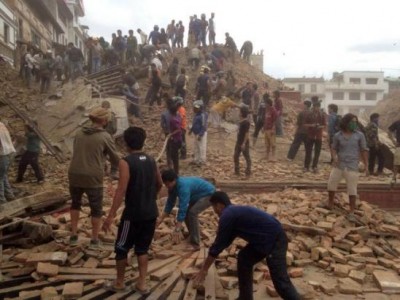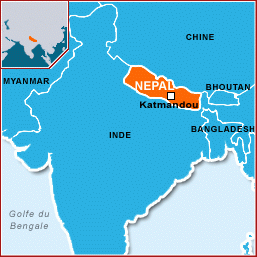|
Kathmandu in the Wake of the Earthquake: Three women in search of Muna’s House—a Nepal guide to Gongabu
|
By Barbara Nimri Aziz
Global Research, May 11, 2015
|
Url of this article:
https://www.globalresearch.ca/kathmandu-in-the-wake-of-the-earthquake-three-women-in-search-of-munas-house-a-nepal-guide-to-gongabu/5448761
|

There’s a patch of Nepal I’d never seen before–it’s called Buspark or Gongabu, (“cock-field”). Since there’s no guidebook available—I found it by chance in my search for Muna’s mother. She’s the woman left alone and brokenhearted when her daughter, Muna our Amrit student, and husband were crushed in their home 2 weeks ago. “Where is Umm Muna and how can we assist her?” asks an Iraqi friend– my anonymous, irrepressible humanitarian on this blog elist. Sukanya our school director is concerned too—“We might learn more when school resumes and her schoolmates return next week”. But Sukanya, expedient, ever dependable Sukanya, is not someone who willingly delays. She calls Rita, one of our teachers and within 10 minutes, the three of us set out together on foot. Muna’s family apartment was somewhere near the school– just here, just here. “Just here” turns into my discovery of the now infamous Gongabu.
There I’ll enter another world although it’s barely a quarter hour stroll from our Amrit school and the famous Mehpi —“empowered-place”– hilltop. This local prominence is crowned by Mehpi temple and surrounded with a modest forest that draws early morning worshippers and neighbors seeking clean air in the early hours before city smog envelops us, and ahead of local traffic snarling through Mehpi district.
 A lane veering northward off the circle through which Rita leads us is new to me. Well before reaching Muna’s neighborhood, it is evident that I’m venturing into an unhappy corner of Kathmandu where life is hard any day and still precarious, if not dangerous, after the quake. We three women reach a point where vehicles are prohibited; even foot traffic is unadvisable. Anyone without a mission here ought to stay away. And at midday I sense people here are uncustomarily scarce, and those here seem subdued. A lane veering northward off the circle through which Rita leads us is new to me. Well before reaching Muna’s neighborhood, it is evident that I’m venturing into an unhappy corner of Kathmandu where life is hard any day and still precarious, if not dangerous, after the quake. We three women reach a point where vehicles are prohibited; even foot traffic is unadvisable. Anyone without a mission here ought to stay away. And at midday I sense people here are uncustomarily scarce, and those here seem subdued.
An unconvincing and unauthoritative barrier of small boulders and wires are tangled around a thick bamboo pole lying across part of the road. Rita steps over them boldly. So Sukanya and I follow, leaving a cluster of men who stand among the many we’ll meet in the next 200 meters staring at the devastation across the street. A crushed taxi is motionless by the curb and heaps of bricks flank the cleared path down the street we enter. Frankly I’m ready to turn back, but Rita had her assignment. Confidently she points out corner pillars—“there, up, up further, through that passage there—see, see those cracks at the base, see up the walls, this building, that one too.” Open windows exposed limp curtains protecting nothing inside. No posting is needed to tell us all are vacant, and although these facades show little evidence of damage beyond those cracks, all these four-story structures are either condemned (red code) or dangerous (orange?). Don’t go further, says one bystander. But Rita presses on.
Two soldiers walking towards us turn a corner and proceed slowly into a deserted street, notepads or phones in hand. I prefer to interview them, but Rita again invites me to proceed with her. A hundred feet ahead we reach Muna’s. The brick structure leans towards us at a 30-45 degree angle, held there against a structure that’s upright but no less precarious. I’m exerting my imagination to understand how even a rescue team would even dare to search for bodies here.
Her’s was retrieved a day after, but it took six for rescuers to find her father, (and a nephew who perished here with them). This detail, Rita gathers from a man seated in front of his shop across the way (the only occupied space in his 4 story building). And Umm Mona? “She’s returned; she’d gone to their village in District 3, (far east Nepal, maybe Illam) after the quake. She’d not been normal following the death of her boy 18 months ago. Want her number?” So Rita records it; we’ll contact her later. (I’m not prepared to speak with her this afternoon.)
I’m obliged to proceed further only by the daring and resolve of Rita herself. (Sukanya also continues unprotesting, despite her 79 years and aching knees). Not far beyond Muna’s, the street opens up into an ugly, hazy panorama framed in noise, oil fumes, stink and dust. “This is Buspark” signals Rita, arm outstretched to a wall of corrugated iron sheets. From that gap in the gateway, a row of buses is emerging onto the congestion of Ring Road to make their way out of the capital. We step back, but there will be no retreating.
As we wait for a line of 10 or so buses to lumber past us, Sukanya reads the banners painted at the top of their windshields— Biratnagar, Rajbiraj, Janakpur (east Nepal), Hetauda, Birganj, Bharatpur, Pokara, Bhutwal (south and west) –[I’ll check spellings on a map back at Nirmal’s library).
Ahhh: this is the long-distance bus depot linking the city with far flung corners of Nepal. So I suppose it’s reasonable that what looms there behind the traffic on the main artery across from us is a migrant slum that’s Gongabu. Hardly an image to compete with the toppled UNESCO-protected grand temples in the Darbar Squares of the ancient Malla cities of Bhaktapur and Patan and Hanumandoka centered in Kathmandu city, that represent ongoing Newar identity and culture. (As our Amrit alumni student __���____ said : “We have lost our pride”—then gently adding, “our heritage”).
These sites [Google them, and Gongabu too while you’re at it] are highly appreciated for their art and thereby for tourist value in the economy; already foreign scholars (Gerard Toffin, at C.N.R.S, Paris; Michael Hutt, S.O.A.S. [my alma mater], London) and international agencies are writing and meeting about the urgency and costs of their restoration, with commitments already made.
Sorry, I digress.
Back to Gongabu where our only guidebook is oral—teacher Rita.
There’s more to come, and we three hesitatingly make our way across the main thoroughfare, and down a path following the open sewer that is the Bagmati River (!). (I feel sticky all over, and behind my mask my mouth is dry and my breathing difficult) Here I witness a slum city of hundreds of 6-7 story structures, endlessly packed against each other with hardly a street to distinguish them. Some post names like Pari Guest House and Morang Lodge.
Now I understand where those millions of migrants stay. Either they lodge here temporarily (where many are robbed, beaten or killed for the cash (earnings they have returned with insecured in backpacks and suitcases) enroute home from years of toil in Malaysia and Gulf states. Or, this is where their families rent apartments; tenants here are rural migrants who’ve abandoned villages to live as consumers off the cash those brothers, husbands and sons send as remittances from distant jobs. Perhaps some of those lads flying with me on that Etihad Airways flight 13-14 days ago have relatives residing in Gangabu. That is to say, they had. “They (these apartment slums) are all empty now”. I pause and speak to a pharmacist leaning (masked like me) across his open counter: Where are they? “Their villages; they’ve gone home.”
It’s becoming clear—they left not only because they are concerned for their village homes. They are afraid to stay HERE, in these hastily build, illegally constructed, cramped and precarious code-defying structures. Whole blocks have collapsed, only sustained partly upright by the buildings around them. And many perished here—the bodies of some unretrievable. So perhaps those laborers and families fled these death traps. Yes, I think so now.
Gongabu is familiar to Kathmandu citizens as a migrant slum. It’s also widely known that these many blocks were constructed illegally, that this area was known to be a swamp with soft land (the early name Machhe Pokari-fish bond, a dryless place is nearby), unsuitable for dwellings, where wells were dug illegally here and where water is impossibly inadequate. So when other city residents heard of the April 25 death toll in Gongabu, they weren’t surprised. Now, who will dare to raze these structures–the government, the landlords? And who would stop the migrants from re-occupying? And where would these families go when they come back to the city?
Rita and her two sturdy companions return to the main road, skirting busses and trucks, scooters and cars for another wearisome half mile until we reach the junction at Machhe Pokari. A beautiful name, no? But I assure you what lays there is a bleak scene, with more scars from the quake. (I need a shower; I need to write. )
Addenda:
(Why is there such dust after last night’s storm and the noisy rain that filled our house’s reservoirs and sent my host rushing to the roof to manage his proudly installed collection system?)
I’ll meet Utpalla this evening; she’s Nirmal’s sister-in-law (living with her son, daughter and husband on the first floor of this family house). Utpalla’s due to return from a more promising mission than mine– to Dharmasatila town an hour from the capital. She a member of the Shree Shree Kuman (women’s) Committee who’ve collected funds to deliver truckloads of supplies to homeless villagers (all farmers; 300 of 310 houses collapsed; school is intact.) I’ll learn her 30 member relief committee teamed up with a Malaysian delegation that have arrived in Nepal a few days back with 40 two-family tents and 350 sleeping bags, tarps, food, etc. (Sree Sree Kuman is one of the hundreds of private Nepali associations and ad hoc groups, who, despairing of the government, joined each other and friends across the country and world to launch emergency relief.)
(No one has informed me of one government project like these; although we can end with a promising note: i.e. the Nepali army and police forces seem to have been outstanding during these urgent, painful days. I’m told they’ve shown themselves totally dedicated, unbiased, and immune from the party politics which has infected government relief obligations and angered so many citizens.)
For Tuesday: Musician and writer Nirveya has agreed to take me on his motorcycle to hard-hit Sanku village just 30 km from here. I know that Sanku residents have received supplies but I need to see conditions for myself. I need to get out of Kathmandu.
Before beginning her journalistic work in the Arab lands, anthropologist Barbara Nimri Aziz spent several decades conducting research in the Himalayan areas. Her books include “Tibetan Frontier Families”, “Soundings in Tibetan Civilization”, (both reprinted in 2011) and “Heir to a Silent Song: Two Rebel Women of Nepal” (2001) all available through Vajra Books, Kathmandu (vajrabooks.com.np). Her latest book is “Swimming Up The Tigris: Real Life Encounters With Iraq”, U. Press Florida, 2007.
|
|
Disclaimer: The contents of this article are of sole responsibility of the author(s). The Centre for Research on Globalization will not be responsible for any inaccurate or incorrect statement in this article.
|
|
|
|